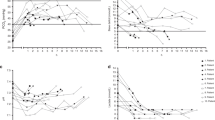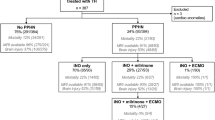Abstract
Objective
To evaluate the association between hypocapnia within the first 24 h of life and brain injury assessed by a detailed MRI scoring system in infants receiving therapeutic hypothermia (TH) for neonatal encephalopathy (NE) stratified by the stage of NE.
Study design
This retrospective cohort study included infants who received TH for mild to severe NE.
Results
188 infants were included in the study with 48% having mild and 52% moderate-severe NE. Infants with moderate-severe NE spent more time in hypocapnia (PCO2 ≤ 35 mmHg) and presented with more severe brain injury on MRI compared to mild cases. The MRI injury score increased by 6% for each extra hour spent in hypocapnic range in infants with moderate-severe NE. There was no association between hypocapnia and injury scores in mild cases.
Conclusion
In infants with moderate-severe NE, the hours spent in hypocapnia was an independent predictor of brain injury.
This is a preview of subscription content, access via your institution
Access options
Subscribe to this journal
Receive 12 print issues and online access
$259.00 per year
only $21.58 per issue
Buy this article
- Purchase on Springer Link
- Instant access to full article PDF
Prices may be subject to local taxes which are calculated during checkout

Similar content being viewed by others
References
Jacobs SE, Berg M, Hunt R, Tarnow-Mordi WO, Inder TE, Davis PG. Cooling for newborns with hypoxic ischaemic encephalopathy. Cochrane Database Syst Rev. 2013;1:CD003311.
Pappas A, Shankaran S, Laptook AR, Langer JC, Bara R, Ehrenkranz RA, et al. Hypocarbia and adverse outcome in neonatal hypoxic-ischemic encephalopathy. J Pediatr. 2011;158:752–8.
Lingappan K, Kaiser JR, Srinivasan C, Gunn AJ. Relationship between PCO2 and unfavorable outcome in infants with moderate-to-severe hypoxic ischemic encephalopathy. Pediatr Res. 2016;80:204–8.
Lopez Laporte MA, Wang H, Sanon PN, Barbosa Vargas S, Maluorni J, Rampakakis E, et al. Association between hypocapnia and ventilation during the first days of life and brain injury in asphyxiated newborns treated with hypothermia. J Matern Fetal Neonatal Med. 2019;32:1312–20.
El-Dib M, Inder TE, Chalak LF, Massaro AN, Thoresen M, Gunn AJ. Should therapeutic hypothermia be offered to babies with mild neonatal encephalopathy in the first 6 h after birth? Pediatr Res. 2019;85:442–8.
Walsh BH, El-Shibiny H, Munster C, Yang E, Inder TE, El-Dib M. Differences in standardized neonatal encephalopathy exam criteria may impact therapeutic hypothermia eligibility. Pediatr Res. 2021. https://doi.org/10.1038/s41390-021-01834-7. Online ahead of print.
Shankaran S, Laptook AR, Ehrenkranz RA, Tyson JE, McDonald SA, Donovan EF, et al. Whole-body hypothermia for neonates with hypoxic-ischemic encephalopathy. N Engl J Med. 2005;353:1574–84.
Azzopardi DV, Strohm B, Edwards AD, Dyet L, Halliday HL, Juszczak E, et al. Moderate hypothermia to treat perinatal asphyxial encephalopathy. N Engl J Med. 2009;361:1349–58.
Weeke LC, Groenendaal F, Mudigonda K, Blennow M, Lequin MH, Meiners LC, et al. A novel magnetic resonance imaging score predicts neurodevelopmental outcome after perinatal asphyxia and therapeutic hypothermia. J Pediatr 2018;192:33–40.e2.
Szakmar E, Meunier H, El-Dib M, Yang E, Inder TE. Interobserver reliability of an MR imaging scoring system in infants with hypoxic-ischemic encephalopathy. Am J Neuroradiol. 2021;42:969–74.
Hayat MJ, Higgins M. Understanding poisson regression. J Nurs Educ. 2014;53:207–15.
Klinger G, Beyene J, Shah P, Perlman M. Do hyperoxaemia and hypocapnia add to the risk of brain injury after intrapartum asphyxia? Arch Dis Child Fetal Neonatal Ed. 2005;90:F49–52.
Greisen G. Autoregulation of cerebral blood flow in newborn babies. Early Hum Dev. 2005;81:423–8.
Molloy EJ, Cummins EP. Carbon dioxide as a drug in neonatology. Pediatr Res. 2021;89:1049–50.
Laffey JG, Kavanagh BP. Medical progress—hypocapnia. N Engl J Med. 2002;347:43–53.
El-Dib M, Szakmar E, Chakkarapani E, Aly H, Newborn Brain Society G, Publications C. Challenges in respiratory management during therapeutic hypothermia for neonatal encephalopathy. Semin Fetal Neonatal Med. 2021;26:101263.
Szakmar E, Kovacs K, Meder U, Bokodi G, Andorka C, Lakatos A, et al. Neonatal encephalopathy therapy optimization for better neuroprotection with inhalation of CO(2): the HENRIC feasibility and safety trial. Pediatr Res. 2020;87:1025–32.
Collins MP, Lorenz JM, Jetton JR, Paneth N. Hypocapnia and other ventilation-related risk factors for cerebral palsy in low birth weight infants. Pediatr Res. 2001;50:712–9.
Okumura A, Hayakawa F, Kato T, Itomi K, Maruyama K, Ishihara N, et al. Hypocarbia in preterm infants with periventricular leukomalacia: the relation between hypocarbia and mechanical ventilation. Pediatrics. 2001;107:469–75.
Calvert SA, Hoskins EM, Fong KW, Forsyth SC. Etiological factors associated with the development of periventricular leukomalacia. Acta Paediatr Scand. 1987;76:254–9.
Schneider AG, Eastwood GM, Bellomo R, Bailey M, Lipcsey M, Pilcher D, et al. Arterial carbon dioxide tension and outcome in patients admitted to the intensive care unit after cardiac arrest. Resuscitation. 2013;84:927–34.
Walsh BH, Neil J, Morey J, Yang E, Silvera MV, Inder TE, et al. The frequency and severity of magnetic resonance imaging abnormalities in infants with mild neonatal encephalopathy. J Pediatr. 2017;187:26–33.
Finder M, Boylan GB, Twomey D, Ahearne C, Murray DM, Hallberg B. Two-year neurodevelopmental outcomes after mild hypoxic ischemic encephalopathy in the era of therapeutic hypothermia. JAMA Pediatr. 2020;174:48–55.
Conway JM, Walsh BH, Boylan GB, Murray DM. Mild hypoxic ischaemic encephalopathy and long term neurodevelopmental outcome—a systematic review. Early Hum Dev. 2018;120:80–7.
Szakmar E, Jermendy A, El-Dib M. Respiratory management during therapeutic hypothermia for hypoxic-ischemic encephalopathy. J Perinatol. 2019;39:763–73.
de Vries LS, Groenendaal F. Patterns of neonatal hypoxic-ischaemic brain injury. Neuroradiology. 2010;52:555–66.
Alderliesten T, de Vries LS, Staats L, van Haastert IC, Weeke L, Benders MJ, et al. MRI and spectroscopy in (near) term neonates with perinatal asphyxia and therapeutic hypothermia. Arch Dis Child Fetal Neonatal Ed. 2017;102:F147–F52.
Acknowledgements
We thank our statistician, Laszlo Szakacs, for his expert help with data management and analysis.
Author information
Authors and Affiliations
Contributions
ESz had substantial contributions to conception and design, data analysis, and interpretation of data. She also drafted the article and had final approval of the version to be published. CM and HE helped to collect and analyze the data and to write the manuscript draft. AJ and TI had substantial contributions to conception and interpretation of data, and revised the manuscript for important intellectual content. ME conceptualized and designed the study, supervised all aspects and critically reviewed the manuscript. All authors approved the final manuscript as submitted and agree to be accountable for all aspects of the work.
Corresponding author
Ethics declarations
Competing interests
The authors declare no competing interests.
Ethics approval and consent to participate
This study was approved by the Partners Human Research Committee Institutional Review Board and consent was waived (IRB protocol# 2014P002430).
Additional information
Publisher’s note Springer Nature remains neutral with regard to jurisdictional claims in published maps and institutional affiliations.
Supplementary information
Rights and permissions
About this article
Cite this article
Szakmar, E., Munster, C., El-Shibiny, H. et al. Hypocapnia in early hours of life is associated with brain injury in moderate to severe neonatal encephalopathy. J Perinatol 42, 892–897 (2022). https://doi.org/10.1038/s41372-022-01398-2
Received:
Revised:
Accepted:
Published:
Issue Date:
DOI: https://doi.org/10.1038/s41372-022-01398-2



